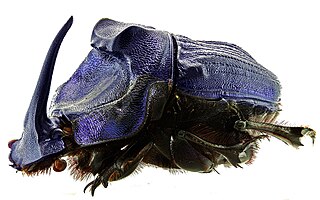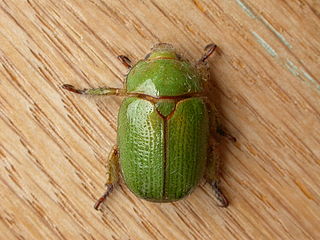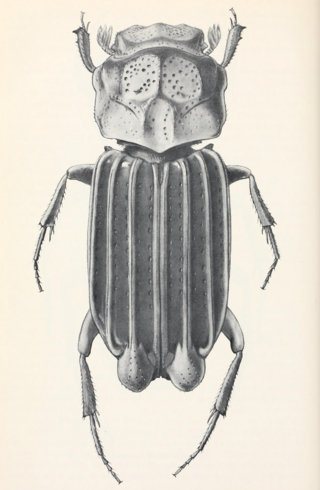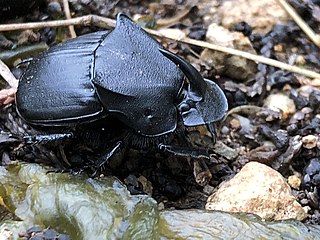
Phanaeus vindex, the rainbow scarab, is a North American species of true dung beetle in the family Scarabaeidae. It is found in eastern and central United States and in adjacent far northern Mexico. It is the most widespread species of Phanaeus in the United States and it has a wide habitat tolerance. It may hybridize with the generally less common P. difformis.

Mesonauta, the flag cichlids, is a small genus of cichlids native to the Amazon, Orinoco, Essequibo, Paraná and Paraguay basins in South America. Mesonauta is included in the subfamily Cichlasomatinae. They occur in various freshwater habitats such as streams and lakes, especially in areas with little water movement and aquatic vegetation. They are generally found in small groups that stay near the water surface. To avoid predators, adults may jump out of the water and juveniles mimic leaves.

Ataenius is a genus of aphodiine dung beetles in the family Scarabaeidae. There are at least 290 described species in Ataenius.

Coprophanaeus is a genus in the family Scarabaeidae. The genus is almost entirely Neotropical, with a single species, C. pluto, ranging into southernmost Texas in the United States. They are medium-sized to large beetles, with the South American C. ensifer and C. lancifer sometimes exceeding 5 cm (2 in) in length, making these two some of the largest dung beetles in the world and the largest in the Americas. They often have a horn on the head, and are typically a bright metallic color, most often blue or green, or black. These diurnal or crepuscular beetles are excellent diggers and good fliers.

Aegialiinae is a small subfamily of the family Scarabaeidae. Historically the group has been treated as a tribe within a broad definition of the subfamily Aphodiinae.

Coprophanaeus ensifer is a large South American species of beetle belonging to the family Scarabaeidae.

Phanaeus, the rainbow scarabs, is a genus of true dung beetles in the family Scarabaeidae, ranging from the United States to northern Argentina, with the highest species richness in Mexico. Depending on species, they can inhabit a wide range of habitats, from tropical to temperate climates and deserts to rainforests. In those living in relatively arid places adults are primarily active during the wet season and those living in relatively cold places are primarily active during the summer. They are excellent diggers and good fliers.

Phanaeus demon is a species of beetles belonging to the family Scarabaeidae. This species is often incorrectly named as "damon" in collections and in the literature.

Sulcophanaeus is a genus of dung beetles belonging to the family Scarabaeidae. Most species in this genus are from tropical and subtropical South America, but a few are found in Central America and Mexico, and S. carnifex is from Jamaica. Sulcophanaeus are mostly coprophagous, but some are also necrophagous. They are paracoprids, meaning that adults dig tunnels into the soil under the food source and move parts of the food source to a nest chamber where the eggs are laid, and their activity pattern varies depending on species.

Anoplognathus prasinus, commonly known as the green Christmas beetle, is a beetle of the family Scarabaeidae native to eastern Australia.

Oxysternon festivum is a species of dung beetle of the scarab beetle family. It is a common, diurnal species from northeastern South America and Trinidad where it mostly inhabits forest.

Cartwrightia is a genus of scarab found in Latin America. It was named and circumscribed in 1958 by Federico Islas Salas. As of 2017, three species are recognized: C. intertribalis, C. cartwrighti, and C. islasi. They can be found in the nests of leafcutter ants or in dung.

Cartwrightia cartwrighti is a species of aphodiine scarab found in South America. Oscar L. Cartwright named the species in 1967 after his brother. C. cartwrighti has been recorded in cow dung in pastures and forests.

Phanaeus difformis is a species of true dung beetle in the family Scarabaeidae that is native to south-central United States and adjacent far northern Mexico. It may hybridize with the generally more common P. vindex.

Phanaeini is a tribe of dung beetles in the family Scarabaeidae. There are about 12 genera and 200 described species in Phanaeini. They are native to the Americas with the highest species richness in the Neotropics. They are mostly coprophagous or necrophagous, but some of the least known genera appear to be myrmecophilous. They are medium-sized to large beetles, often with bright metallic colors, and often with horns on their heads.

Macrodactylini is a tribe of May beetles and junebugs in the family Scarabaeidae. There are at least 46 genera and over a thousand species described in the tribe Macrodactylini.

Phanaeus adonis is a species of true dung beetle in the family Scarabaeidae, found primarily in north-central Mexico, but also ranging into Cameron County in far southern Texas, United States.

Phanaeus triangularis, the black phanaeus, is a North American species of true dung beetle in the family Scarabaeidae. It is found in the eastern half of the United States.

Oxysternon conspicillatum is a species of dung beetle in the family Scarabaeidae. It is found in both evergreen and semi-deciduous mesic forests, including disturbed habitats, ranging from near sea level to an altitude of 3,000 m (9,800 ft) in the Amazon basin and Chocó of tropical South America and Panama, possibly extending as far west as the border region with Costa Rica. Both adults and young of this common and widespread beetle primarily feed on dung, but the species has also been recorded feeding on dead animals.

Scarabaeus gangeticus, is a species of dung beetle found in many Indo-African countries including; India, Sri Lanka, Pakistan, Iran, Saudi Arabia, Egypt, Botswana, Ethiopia, Somalia, Uganda and Zimbabwe.




















